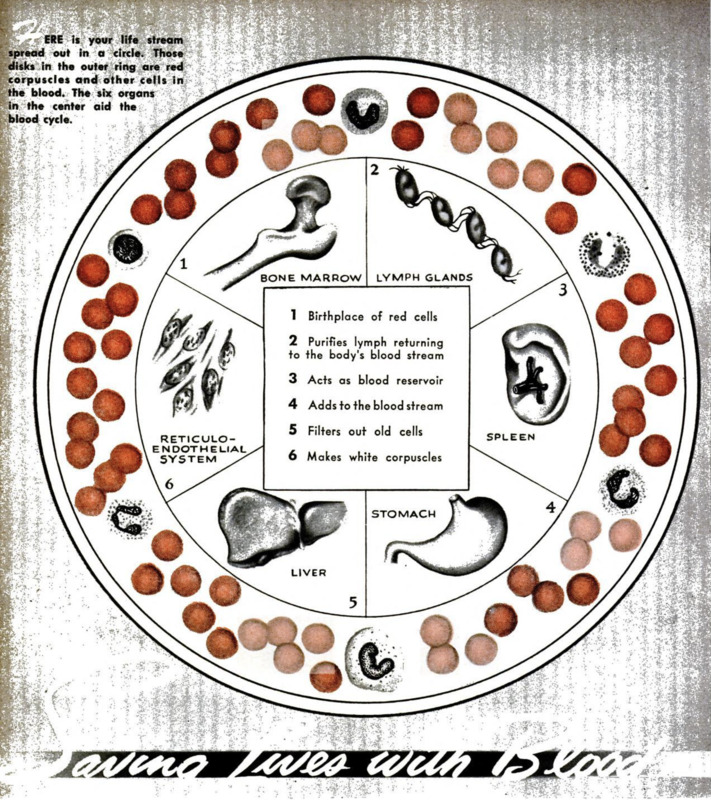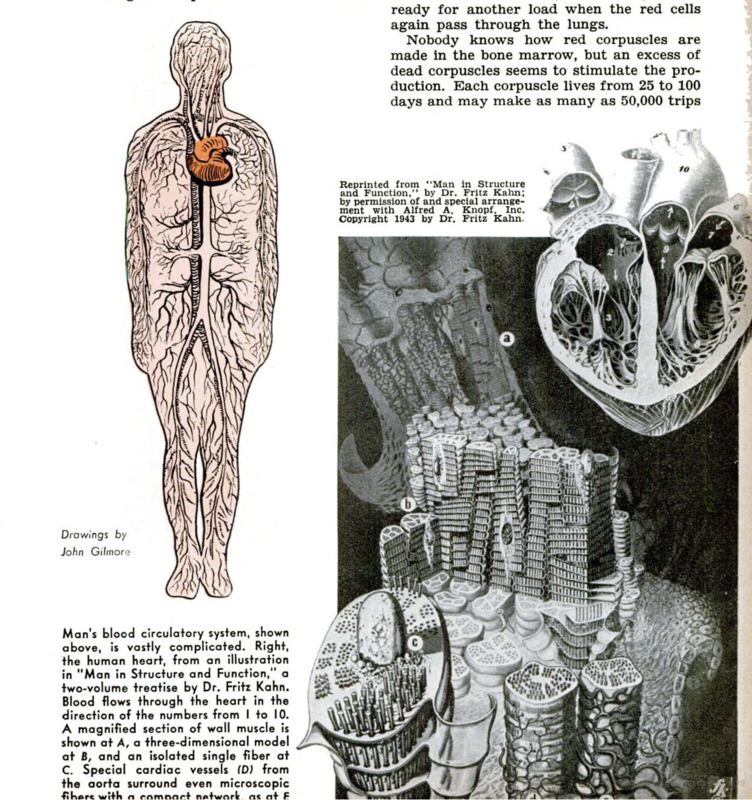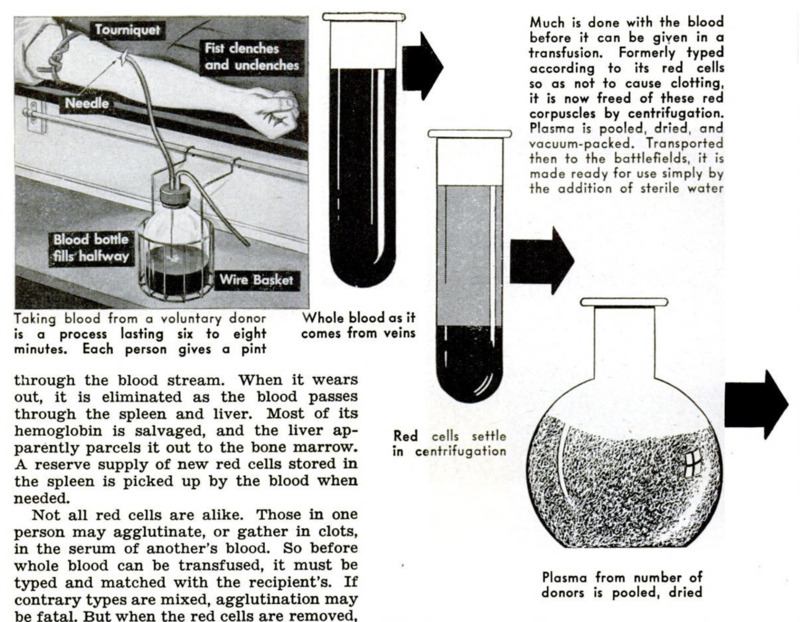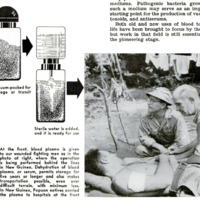-
Title (Dublin Core)
-
Saving Lives with Blood
-
Article Title and/or Image Caption (Dublin Core)
-
Saving Lives with Blood
-
extracted text (Extract Text)
-
DOCTORS once bled patients to cure them,
thinking blood contained “ill humors”
that made them sick. Today doctors bleed
blood donors to cure others, for science has
learned that human blood contains a whole
warehouse of curative agents. Plasma for
transfusion is only one of a dozen blood
products now in use. Blood has become a
major strategic weapon—to help save lives.
A donor who contributes a pint of blood is
giving about one fourteenth of the amount
in his system. In a person of normal health
that pint is replaced within a few days, for
the manufacture of blood is a basic function
of the body. The red bone marrow, where
the red blood cells originate, can make
10,000,000 cells a second. The average per-
son's blood contains trillions of these red
cells; but even that astronomical quantity
can be replaced in about 15 days.
Human blood consists of approximately
equal portions of corpuscles, or blood cells,
and plasma—the river in which the cor-
puscles float. Plasma is about 92 percent
water. In it are dissolved salts of sodium,
calcium, potassium, and phosphorus along
with albumin, other proteins, and fatty sub-
stances. All are important, not only in the
blood’s normal function, but in the curative
products science can now extract from
blood itself.
Floating in the plasma are several kinds
of white corpuscles, red corpuscles, and
small colorless bodies called “platelets.” The
white corpuscles can pass through the walls
of the capillaries directly into the body tis-
sues; they are the scavengers and defenders
of the body, consuming dead cells, waste
products, and bacteria, and healing wounds.
The red corpuscles, which cannot leave the
blood vessels, carry oxygen from the lungs
to the tissues. The platelets play an im-
portant part in clotting.
The red cells are like barges, simply mak-
ing the rounds of the blood stream with their
cargoes of hemoglobin, which gives them
their color, absorbs oxygen in the lungs,
takes it to the tissues, releases it, and is
ready for another load when the red cells
again pass through the lungs.
Nobody knows how red corpuscles are
made in the bone marrow, but an excess of
dead corpuscles seems to stimulate the pro-
duction. Each corpuscle lives from 25 to 100
days and may make as many as 50,000 trips
through the blood stream. When it wears
out, It 1a eliminated us the blood passes
through the spleen and liver. Most of its
hemoglobin is salvaged, and the liver ap-
parently parcels it out to the bone marrow.
‘A reserve supply of new red cells stored in
the spleen is picked up by the blood When
needed.
Not al red cells are alike. Those In one
‘person may agglutinate, or gather in clots,
in the serum of another's blood. So before
whole blood can be transfused, it must be
typed and matched with the recipient's. It
contrary types are mixed, agglutination may
be fatal. But when the red cells are removed,
plasma can be put in any other person's
blood stream without il effects, This is a
reason for preferring plasma. for trans.
fusions.
There are several types of white cor-
puscles. Besides ordinary leucocytes that
defend the body against infection, there are
lymphocytes that carry the means of mak-
ing a person immune to disease. When a
person has a disease, lymphocytes acquire
‘Weapons to fight a recurrence. Though rela-
tively few in number, they are extremely
potent. Science is learning more about them.
every day and is beginning to put them to
work.
Among the soluble proteins in plasma are
fibrinogen and prothrombin. In the plate-
lets and body tissues is a substance called
thrombokinase. When tissues are broken, as
in a wound, both tissues and platelets Te-
lease thrombokinase which, With the cal-
clum in plasma, changes prothrombin to
thrombin. The thrombin in turn changes
fibrinogen to fibrin, an insoluble mass of
‘woolly fibers in which the red corpuscles are
enmeshed like fish in a meine,
It only a vein is ruptured, the clot stops
the loss of blood and the white corpuscles
repair the damage. If an artery is severed,
however, outside help is needed, for the clot
cannot hold against the direct thrust of the
heart.
The heart is simply a pump, and, like all
pumps, it must have something to pump or
it cannot function. There are two ways in
which blood pressure may fall to a danger-
ous level—a reduction of the volume of
blood, as in a hemorrhage, and an expansion
of the circulatory system making the normal
volume inadequate, as in shock. In a hemor-
rhage, the volume must be restored to nor-
mal; in shock, the pressure must be restored.
Transfusion may be required in either case.
Early transfusions employed animal blood,
particularly that of sheep, and were usually
fatal because the two types of blood would
Dot mix. The next step was the use of salt
solutions, with somewhat greater Success.
Then hurran blood was transfused, with far
greater success after procedures were found
for typing and matching. Finally came the
relatively new use of blood serum, which
has been highly successful. Fresh serum,
shipped to England under refrigeration,
saved thousands of lives during the blitz
on London. Dried serum is a further devel-
opment that permits storage and shipment
with a minimum of loss—it can be kept for
five years, and dilution with sterile water
makes it available for use anywhere.
Now an even better transfusion agent is
being made from the serum itself—serum
albumin. This extract is more concentrated,
produces no adverse reactions, and requires
a minimum of sterile water—an important
factor in battle, particularly in desert or
jungle. By its very nature, serum albumin
prompts the body to supply the water needed
to restore the blood to normal volume. The
body can supply that water by drinking it,
and potable water is always easier to get
than water for injection.
From the serum also can be obtained
fibrinogen and thrombin. By using these
two substances separately, science has a new
means of treating severe burns. The wound
is sprayed with fibrinogen, then with throm-
bin. This forms a clot that normally be-
comes a scab and protects the area from
outside infection, retains the white cor-
puscles that the body throws into the injured
tissue, and allows the wound to drain
naturally.
Another plasma derivative is gamma glob-
ulin, which apparently contains the pro-
tective antibodies that enable lymphocytes
to resist recurrence of a disease. About nine
of every 10 persons have had such virus
diseases as mumps, measles, and influenza.
‘When donors’ blood is pooled, the antibodies
are distributed, and when the gamma globu-
lin is extracted, it seems to contain a potent
concentration of those antibodies, sufficient
to immunize anyone to whom it is adminis-
tered. On the basis of laboratory work, such
injections will enable doctors to halt an
epidemic of a virus disease in its tracks.
‘Until recently, red corpuscles removed in
the preparation of plasma were a waste
product. Now, however, a means has been
found to use some of them in a poultice type
of treatment that hastens healing of open
wounds. Fresh cells suspended in a saline
solution may also be used for treating
anemia. There is laboratory evidence that
the red cells can eventually provide protein
for peptone, a usual constituent of bacterial
mediums. Pathogenic bacteria grown on
such a medium may serve as an improved
starting point for the production of vaccines,
toxoids, and antiserums.
Both old and new uses of blood to save
life have been brought to focus by the war,
but work in that field is still essentially in
the pioneering stage.
-
Contributor (Dublin Core)
-
Hal Borland (writer)
-
Language (Dublin Core)
-
eng
-
Date Issued (Dublin Core)
-
1943-09
-
pages (Bibliographic Ontology)
-
110-113
-
Rights (Dublin Core)
-
Public Domain (Google digitized)
-
Archived by (Dublin Core)
-
Matteo Ridolfi
-
Alberto Bordignon (Supervisor)
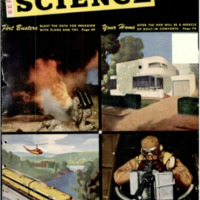 Popular Science Monthly, v. 143, n. 3, 1943
Popular Science Monthly, v. 143, n. 3, 1943

